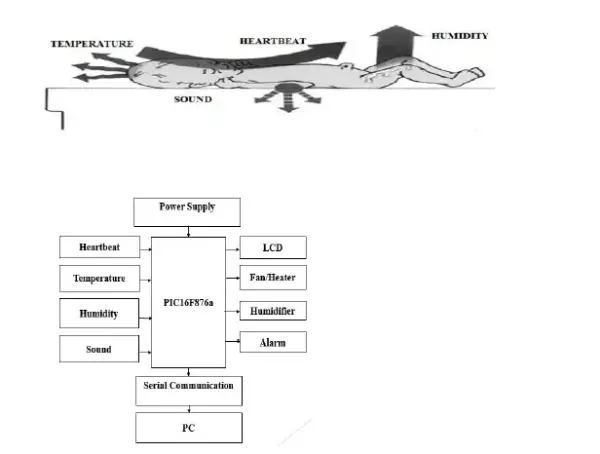INTRODUCTION
1.1-Literature survey
The Smart Jacket for Neonatal Monitoring, designed by Sibrecht Bouwstra, WeiChen, Loe Feijs, and Sidarto Bambang Oetomo, is a sophisticated wearable equipped with sensors aimed at ensuring reliable health monitoring and creating a comfortable clinical environment for neonatal care and parent-child interaction[1]. This paper delves into an innovative solution for challenges related to skin contact by incorporating various sensors stitched into patches mounted on the jacket. The smart jacket, worn by the baby, collects body signals and undergoes signal conditioning. However, a limitation of this system is the necessity for the jacket to be in direct contact with the body due to the inclusion of different sensors in the module.
In a separate development, Karthik Hiremath has conceptualized a Neonatal Intensive Care Unit designed to establish an environment that minimizes stress on the infant while fulfilling essential needs such as warmth, nutrition, care, and protection to ensure proper growth and development[2]. The primary focus of this paper is to introduce a fully automated iteration of the Neonatal Intensive Care Unit, employing the PIC 18F4520 and Zig Bee technology.
The limitation of this system is its capability restricted to counting the pulse rate and sensing the temperature of both the infant and the incubator.
In the development of a Wireless Monitoring System for Neonatal Intensive Care Unit (NICU) by N.S. Joshi, R.K. Kamat, P.K. Gaikwad, the system focuses on maintaining a stable body temperature crucial for the optimal growth of premature and weak infants. The system utilizes suitable sensors, PIC microcontroller, GSM module, and AT commands for data collection. However, a drawback is identified as reliance on the GSM module, posing a risk if there is no signal range, and it also leads to an increase in cost.
The Design of an Embedded Device for Incubator Monitoring by Prof. Kranti Dive* and Prof. Gitanjali Kulkarni aims to monitor infants in real-time under both clinical and home conditions. The embedded device incorporates sensors for door security, light intensity, and voice detection. However, a drawback is acknowledged as the system primarily concentrates on room security and lacks comprehensive parameters related to the baby’s health.
The Intelligent Baby Monitoring System by Savita P. Patil and Manisha R. Mhetre is designed to provide reliable and efficient monitoring of vital parameters such as body temperature, pulse rate, moisture condition, and infant movement. Utilizing a PIC microcontroller and GSM network, the system transfers information to parents. The drawback identified is the absence of a feature to log the history of the baby’s health.
In the PIC Microcontroller-based Baby Incubator designed by Harshad Joshi and Dattu Shinde, the microcontroller controls and monitors vital parameters like oxygen, temperature, humidity, and heartbeat using a GSM module.
1.2 Proposed System:
2. BLOCK DIAGRAM

3. SYSTEM ARCHITECTURE IN DETAIL
In this project, we employ the PIC 16F876a controller operating at a frequency of up to 20MHz. Various sensors are connected to this PIC, enabling the measurement of different conditions essential for our project. The system involves the computation of parameters such as temperature, humidity, heartbeats, and sound using distinct sensors. These sensors serve as inputs to the controller, with various devices at the output displaying the corresponding readings.
Each sensor is linked to a specific display device; for instance, the temperature sensor output is showcased on an LCD screen. To transmit sensor data to the doctor’s computer, we utilize an RS232 cable. The heart rate sensor yields a digital output synchronized with each heartbeat, featuring a flashing LED. This mechanism operates based on light modulation through blood flow in the finger during each pulse, calculating and displaying the average heart rate on the LCD.
Furthermore, a temperature and humidity sensor module regulates the environmental conditions inside the incubator for both temperature and humidity concerning the baby. Output modules like a humidifier (bulb) and fan come into play to maintain the appropriate clinical environment by adjusting humidity or temperature if they deviate from their predefined set points. This ensures that the baby is kept in a conducive and controlled environment for optimal well-being.
